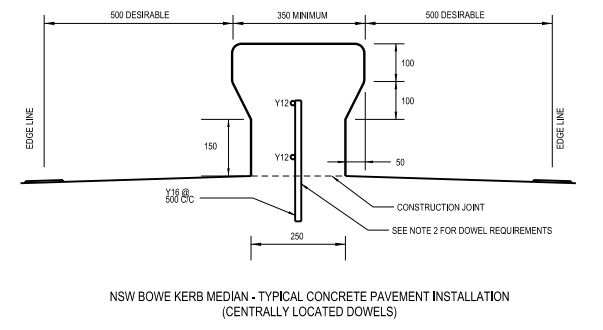
The attached image is of High Profile Redirective Kerb used in NSW, Australia. It does not met the criteria of a MASH road safety barrier, but testing has shown some redirective qualities at lower speeds/ lower mass impacts and lower angle. Although the testing did record a vehicle passing over the kerb at 82 km/h. If this kerb was used in the median of a dual carriageway the coding manual would suggest that it would not be coded in the ‘Median Type’ and coded as a Low rigid object in the ‘Roadside severity - drivers side object’. The result would be a SRS that would be significantly worse than if no device was installed. Is this the right approach or would it be better to code it as a physical median (to note that a % of errant vehicles will cross the median) and as an Upward Slope (to note the increased impact severity)?
It seems to me that the most conservative and correct according to the manual would be to code the “Median Type” as “Physical separation from 0 to 1m” and the severity object as “Low and rigid object” (unless there is another object in the center such as a pole).
But I think you could also consider it as a very particular case. In this sense, you could code it as “Concrete barrier” in “Median Type” and also in severity object, but this only where you are sure that the vehicles do not exceed the speed and weight that you mention (according to studies).
Keep in mind that it must be coded for all types of users, so if heavy vehicles circulate on the road for which the tests for that element are not safe or if it is known that the operating speed on that route is higher than that you mention it’s better to code them as “Low and rigid object”
Thanks Fran,
You raise a number of good points and its show how difficult it can be to code some of the more unique elements on our road networks. I have looked at this more closely and have ran a few scenarios. I was wrong with my original assessment that coding it as a 'Low Rigid Object" would result in significantly worse SRS. I didn’t mention in my original post that the AADT on this road is 50,000. This means Head-On crashes are a concern. By coding a hazard in the median I remove the Head-On crash score from the assessment. I get a larger SRS if I don’t code a hazard! By coding a wider median and a “Downwards Slope”, which doesn’t remove Head-On Crash SRS, then I’m getting a SRS that seems more appropriate. I just feel this is over manipulating the coding.
The limited crash studies that have been done on the kerb would not be enough to code it as a “Concrete Barrier” as some vehicles will not be redirected.
Your last point also raises an issue. Most roads on the Australian network carry heavy vehicles and on the road I’m assessing its around 5-10%. HV in NSW is any vehicle over 4.5t, so the percentage of vehicles not covered by a MASH TL 3 barriers (2t at 100km/h) is even higher. What’s your approach to assessing for HVs when you have a conforming TL3 road safety barrier? The high profile redirective kerb that I’m trying to code will definitely not redirect a HV, but from talking to the road authority (TfNSW) it has helped to reduce Head-On crashes at all the locations it have been installed in.
Hello, I find the depth with which you have analyzed the scores for each type of accident very interesting and important. In reality, sometimes I have also had to vary some coding a bit so that the results are a little more realistic and above all the problem is to understand it and then explain it to the client.
Regarding the last thing you mention, it is possible to reflect it by modifying (very carefully) the data on deaths and injuries on the route.
That is to say, I understand that you have historical accident data on that route “before the installation” of these new elements, if you leave it that way you will not be reflecting the benefit of these elements.
So you could create a scenario where you reduce the types of accidents (in a percentage according to the studies carried out), for example, you reduce frontal collisions by 15% or “runs off the road” by 20%, even depending on the information you have. , you could delimit it by type of vehicle. In summary, in accident data, you would put fewer deaths and injuries and also reduce a little frontal accidents (or those that the studies indicate)
In the event that the element has actually been installed for a long time and the traffic accident data is subsequent to its installation, you could not do this.